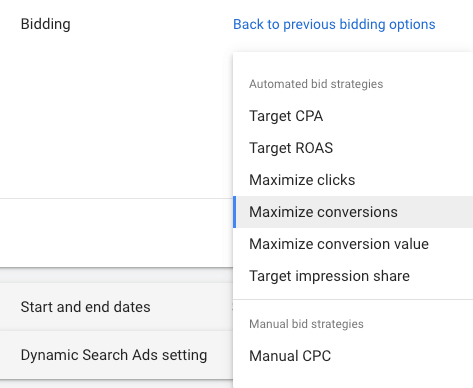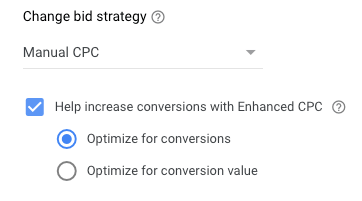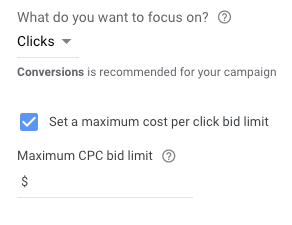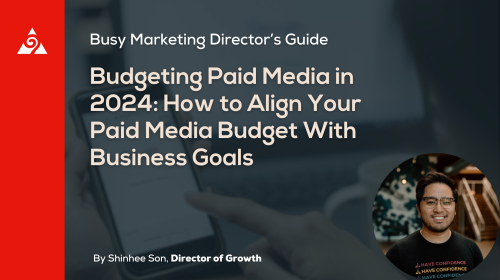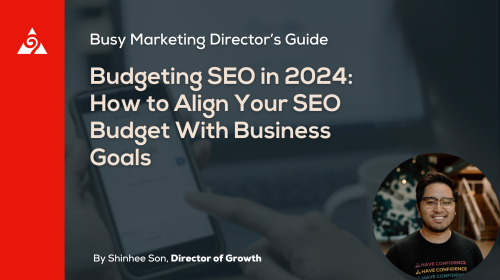Understanding and creating your own Google Ads bidding strategies can be daunting, especially when you’re ready to scale with automated bidding. There’s so much more to bidding in Google Ads than setting and forgetting.
The right Google Ads strategy will reveal the strategic sweet spot where your budget stretches as far as it can to drive as many impressions as possible. Veering too far from that sweet spot means you’ll spend too much money, or you won’t get as many impressions.
To find the best Google Ads bidding strategy and beat the competition, you need up-to-date tactics. This guide will help you understand the core Google Ads bidding strategies so that you can dive deeper into our advanced Google ads bidding strategies and create your own successful campaign.
What Is Bid Strategy in Google Ads and Why Is It Important?
First, let’s answer what is bidding strategy in Google Ads, and why does it matter? Simply put, your bid tells Google Ads: “I will pay up to X amount per click/customer/dollar of revenue”.
The key is finding a bidding strategy that aligns with your budget and customer acquisition goals to achieve your desired outcome.
If your bids are too high, you are likely to show up high on the page, but your budget will be gone before you know it.
If your bids are too low, you may get a stronger return, but Google Ads will not give you as many impressions which will lead to fewer customer acquisitions.
Explore Paid Media Bidding Strategies With Augurian As a Partner.
The 10 Google Ads Bidding Strategies
There are currently 10 main bidding strategies in Google Ads to consider, and Google is always working on improvements. Since the best Google Ads strategy for you depends on your budget and goals, it’s imperative that you get familiar with each strategy, what it offers, and how it may or may not be helpful.
Here’s a list of the strategies that we will summarize below:
- Target CPA (Cost Per Acquisition)
- Target ROAS (Return On Ad Spend)
- Maximize Conversions
- Enhanced Cost Per Click (ECPC)
- Maximize Clicks
- Manual CPC Bidding
- tCPM Bidding (Cost Per Thousand Impressions)
- vCPM Bidding (Cost Per Viewable Thousand Impressions)
- CPV Bidding (Cost Per View)
- Target Impression Share Bidding
Save this guide as a reference for the 10 current bidding strategies, and answers to questions such as “When should I use automated bidding instead of manual bidding?”. By reviewing our guide, you’ll gain a working knowledge of each strategy and when to use it.
Google Ads Bidding Strategy #1: Target CPA
Target CPA (Cost Per Action) is one of the most effective Google bidding strategies for driving conversions at an efficient cost. CPA is the amount of money you’re willing and able to spend on a single conversion. In this scenario, Google’s algorithm is setting your bids to maximize conversion volume within your set target CPA.

How Target CPA works: This strategy lets advertisers set a target cost per action, which Google then uses to adjust bids to generate as many conversions as possible within the target cost per action. Although individual conversions may have CPAs higher or lower than your target, Google tries to balance it out over time to achieve your Target CPA.
As an advertiser, you’re able to set bid minimums and maximums so Google doesn’t go out of your bounds. Keep in mind that this is only for portfolio use; bid caps aren’t available for individual campaigns.
Here’s how our alpha/beta strategy has driven more effective target CPA bidding.
When to use Target CPA
Google Ads recommends that your campaign receives at least 30 conversions in the last 30 days in order for target CPA to perform optimally. If you’d like to try target CPA but your campaign doesn’t have this level of conversion volume, you can use portfolio bidding to apply the tCPA bidding strategy across several campaigns.
Google Ads Bidding Strategy #2: Target ROAS (Return on Ad Spend)
Target ROAS as a strategy is quite similar to Target CPA, but instead of focusing on cost per acquisition, the focus is on return on ad spend (ROAS). With this strategy, Google Ads uses your auction-time signals to predict future conversions and conversion value when entering auctions.
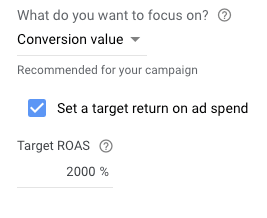
How Target ROAS works: Google Ads uses the return you’re looking for from your ad spend to set bids in a way that maximizes conversion value. Although it takes a little math to figure out, it’s pretty simple to do and very important to know.
The Target ROAS calculation looks like this:
(Sales ÷ ad spend) x 100
If your campaign has sufficient historical data, Google will recommend a ROAS target when you are implementing the bid strategy in your campaign settings.
When to use Target ROAS
Similarly to Target CPA, Target ROAS is best used as an experimental campaign first. One note with Target ROAS is that you will need more data than for Target CPA; Google recommends 50 conversions in the last 30 days for tROAS, opposed to only 30 conversions for tCPA. Therefore, this will likely only be an option for larger budget campaigns. You also must be tracking revenue or value of some sort for your conversions in order for this to work.
Google Ads Bidding Strategy #3: Maximize Conversions
Maximize Conversions is a smart, fully-automated bidding strategy, meaning that Google employs machine learning to optimize conversions and their value across your entire campaign. Google factors in auction-time signals like device location, operation system, time of day, and more to maximize conversions while spending your entire daily budget.

How Maximize Conversions works: This strategy is simple because it’s fairly hands-off. You tell Google how much you want to spend each day, and the algorithm takes it from there to get you the most conversions for your money. Remember, Google will always try to use the full daily budget, so make sure you don’t enter a shared budget.
When to use Maximize Conversions
While it’s optimal that you at least have some conversion history in place, this isn’t necessarily required. This Google Ads bidding strategy could increase spend significantly if your average spend is less than your average daily budget. This is because maximize conversions will try to spend your entire daily budget in pursuit of more possible conversions.
Google Ads Bidding Strategy #4: Enhanced Cost Per Click (ECPC)
Very similar to manual bidding, Enhanced Cost Per Click (ECPC) requires you to manually set the keyword bid but allows Google’s algorithm to increase (or decrease) your bid based on the probability that a query will lead to a conversion.
How Enhanced Cost Per Click works: Based on the likelihood that a click will lead to a conversion, Google Ads can increase or decrease the bid for the keyword you set. Previously, Google allowed for a 30% adjustment on either side, but that cap has since been removed.
Still, Google will work to keep the average CPC below the maximum that you set. Done properly, ECPC can lead to increases in CVR – while allowing you to maintain some control over your bids.
When to use Enhanced Cost Per Click
Enhanced CPC is a good step-up from Manual CPC for advertisers that want to get started with an automated bid strategy while still maintaining some level of control. You don’t need large amounts of data like with target CPA, so small and mid-size advertisers can safely leverage this strategy across any type of campaign.
However, the lack of a spending cap in the algorithm leaves space for bids and CPCs to become so high that they are no longer profitable. This strategy is a good way to test out automation, but keep an eye on CVR to make sure the strategy is working. (Hint: VR will go up if it is).
Google Ads Bidding Strategy #5: Maximize Clicks
Maximize Clicks is quite similar to Maximize Conversions; it’s just focused on clicks instead of conversions. These types of campaign strategies are great for driving more traffic to your site for branding and audience-building, or if you don’t have conversion tracking in place. Maximize Clicks sets your bids to get the maximum number of clicks from your defined budget.
How Maximize Clicks works: Many say this is the simplest way to increase clicks because Google Ads does the majority of the work. Google Ads sets your bids for you to get as many clicks as you can while spending as much of your daily budget as possible. You can set CPC limits to help keep CPCs down as Google spends your daily budget.
When to use Maximize Clicks
Use maximize clicks when the goal of your campaign is to drive traffic to your website. If you don’t have conversion tracking in place, this is a good bidding strategy to use.
Bidding Strategy #6: Manual CPC Bidding
Manual CPC Bidding lets you set your own maximum CPC. This type of bidding is a great starting point because it’s easy to help you get a grasp on Google Ads, and it gives you a level of control that is missing from the automated bidding strategies.
How Manual CPC bidding works: This strategy is designed to give advertisers complete control over their bids. You set each keyword’s bid yourself, and the only way it can change is if you change it manually. There are no algorithms at play that will drive up your cost-per-click (CPC) or make predictions, it’s all up to you.
But, keep in mind that more control costs more of your time. You also miss out on having the added layer of optimization to adjust your bids based on real-time auction signals like time of day, user attributes and online behavior, device, etc.
When to use Manual CPC Bidding
If you have a lot of time on your hands, or simply want to have complete control over your bids, this strategy makes sense. Typically, it’s a safe bet for branded and remarketing campaigns, and even could be great when you are starting out on non-brand campaigns to get a sense of what the cost per click looks like.
Just be prepared to adjust your bids on a regular basis to ensure your bids are meeting the minimum first-page bid, or you risk losing visibility in the SERP. Google has continued to slowly transition advertisers away from manual control and towards automated strategies, so this option may not be around forever.
Google Ads Bidding Strategy #7: tCPM Bidding (target cost-per-thousand impressions)
tCPM bidding, or Target Cost Per Thousand Impressions, is bidding entirely based on impressions. According to Google, it is a way to bid where you pay per one thousand views (impressions) on the Google Display Network. This option is only available for Display campaigns.
How CPM bidding works: It’s completely different from CPC bidding because the bid is focused on the number of impressions an advertisement receives instead of clicks. CPM bidding is charged for every thousand impressions your ad receives.
When to use tCPM Bidding
This strategy is for those targeting in Display Network Campaigns because it helps improve brand visibility. It gets you in front of people and helps more eyes see your message. A disadvantage of this strategy is that you could end up paying for a thousand impressions and receive zero clicks.
Google Ads Bidding Strategy #8: vCPM Bidding (cost per viewable thousand impressions)
Cost Per Viewable Impressions bidding was created from tCPM bidding and also measures how often an ad is seen. While tCPM tracks cost per thousand impressions, vCPM tracks cost per viewable thousand impressions.
An ad is considered viewable when at least 50% of it can be seen on screen (at least one second for display ads, but at least two seconds for video ads).
How vCPM bidding works: This is another display-only strategy made to allow advertisers to bid for impressions. According to Google, with viewable CPM “bids are optimized to favor ad slots that are more likely to become viewable…. You bid on 1,000 viewable impressions and you pay for impressions that are measured as viewable.”
When to use vCPM Bidding
This tactic is best reserved for building brand awareness. It’s available as a bid strategy when you choose CPM bidding for a “Display Network only” campaign. It’s not an option for ‘Search Network only’ campaigns. Google recommends using a higher vCPM bid than your CPM bid to keep your bids competitive and continue to meet your average daily budget.
Google ads Bidding Strategy #9: CPV Bidding (Cost Per View)
This strategy is the default for establishing what you’ll pay for TrueView video ads. CPV bidding simply means that you pay for video views or interactions. This strategy helps you determine the chances that your ad wins the auction and is seen by viewers.
How CPV bidding works: To set a CPV bid, enter the maximum you’re willing to pay for a view in a TrueView video campaign. A view counts if the video ad has been seen for at least 30 seconds or if that ad is interacted with. This is called the max CPV bid and applies to all ads in an ad group.
When to use CPV Bidding
CPV bidding is the default way to bid for video campaigns in Google Ads. This bidding strategy is a good fit if your main campaign goal is to drive video views, rather than something like conversions or clicks.
Google Ads Bidding Strategy #10: Target Impression Share Bidding
Target Impression Share Bidding is a newer strategy designed to let advertisers set a goal impression share percentage in the same way advertisers set a Target CPA. From 2019, it replaced the former options bid strategies Target Search Page Location and Target Outranking Share.
Target Impression Share Bidding offers three locations:
- Absolute top of the page
- Top of the page
- Anywhere on the page
How Target Impression Share Bidding works: Each of the three placement options reveals different preferences to Google’s algorithm, which it then uses to adjust bids. Advertisers can prevent overspending by setting a max CPC bid with Target Impression Share bidding.
When to use Target Impression Share Bidding
Although Target Impression Share bidding can be used for performance, it is best for reaching specified visibility, awareness, and reach goals. This makes it a good option for your brand campaigns because you can ensure your ad always shows when someone searches for your brand. Be careful, though. Like many other paid search bidding strategies, your bids may increase beyond profitability.
To prevent this, always set a max CPC bid or look at your IS before implementing to ensure that your IS target is realistic for your budget. Even though Google cautions against it, look out for yourself and set the bid low to start.
When To Use Automated Bidding
Almost all of the strategies covered in this article are automated bidding strategies, and it’s no coincidence. Automated bidding means that Google Ads will adjust your bids to achieve a particular outcome based on the strategy you selected.
This offers some huge benefits and, as long as you’re vigilant, it can really pay off. One of the best things about automated bidding is flexibility; you can pick what you use and where you use it.
Google Ads lets automated bidding strategies be used at the ad group, campaign, or portfolio level (but this depends on the strategy you choose; some are only for certain levels). This lets you control how much you rely on bid strategies, and helps you to use them to complement your goals. But ad spending can get out of hand and deliver mixed results.
Google Ads also made it as easy as possible to take control of your ads and spending through manual bidding. If you’re uneasy about the automated options, or just prefer to do things yourself, manual bidding is also a good option. Ultimately, which strategy you land on comes down to your evaluation of your budget and goals.
Explore Your Google Ads Bid Strategy With Augurian
At the end of the day, the best bidding strategy in Google Ads depends on your goals.
There is no one right answer for everyone. Bidding strategy is about deciding exactly how you want to spend your paid media budget, and as it turns out, paid media is our specialty.
If you’re struggling to come to a decision, or you’re unsure of how to manage bid strategies for your campaign goals, Augurian can help. Level-up your digital marketing tactics with resources and tips from our paid media blog.
We can work with you to uncover the best ways to reach your goals, stay within budget, and produce results. Explore our expert paid media services, or let’s talk about how Augurian can drive success for your business.
People Also Ask These Questions About Google Ads Bidding Strategies…
Here are other frequently asked questions about bidding strategies…
Are Google Ads and Adwords bidding strategies different?
Nope. Google’s advertising system, which advertisers use to bid on keywords to display their clickable ads in Google’s search results, was called Google Adwords until 2018. In June of 2018, they switched the name to Google Ads. The entire system and strategies remain the same.
Should I bid on brand keywords in Adwords (Google Ads)?
If you would like to dominate your brand SERP, provide users more information, increase CTR, and make it harder for competitors to compete with you, then yes! You should bid on brand keywords.
How should I group my client’s Adwords (Google Ads) campaigns?
The whole point of structuring your ad campaign is to do it in a way that increases effectiveness and profitability. In order to achieve this, you should group your ad campaigns around similar themes or service/product categories.
Which of these Google Ads bidding strategies use machine learning to optimize campaigns?
Google Ads five smart bidding strategies currently include…
- tCPA
- tROAS
- Maximize Conversions
- Maximize Conversion Value
- ECPC
What are some advanced Adwords (Google Ads) strategies?
Here are a few advanced AdWords strategies you can try:
- Add Negative Keywords
- Dynamic Keyword Insertion
- Automated Bidding Strategies
- Remarketing List for Search Ads (RLSA)
- Affinity Targeting

